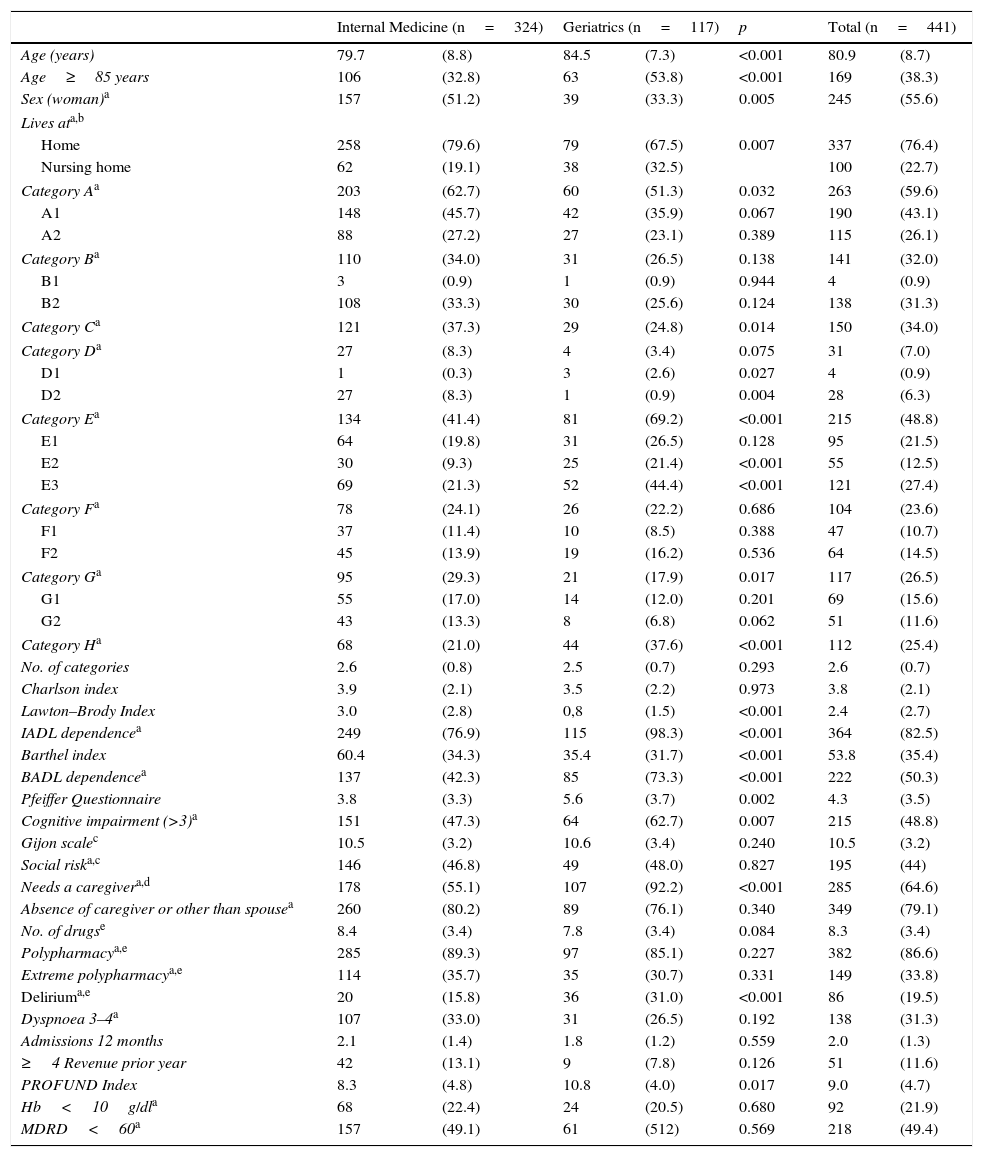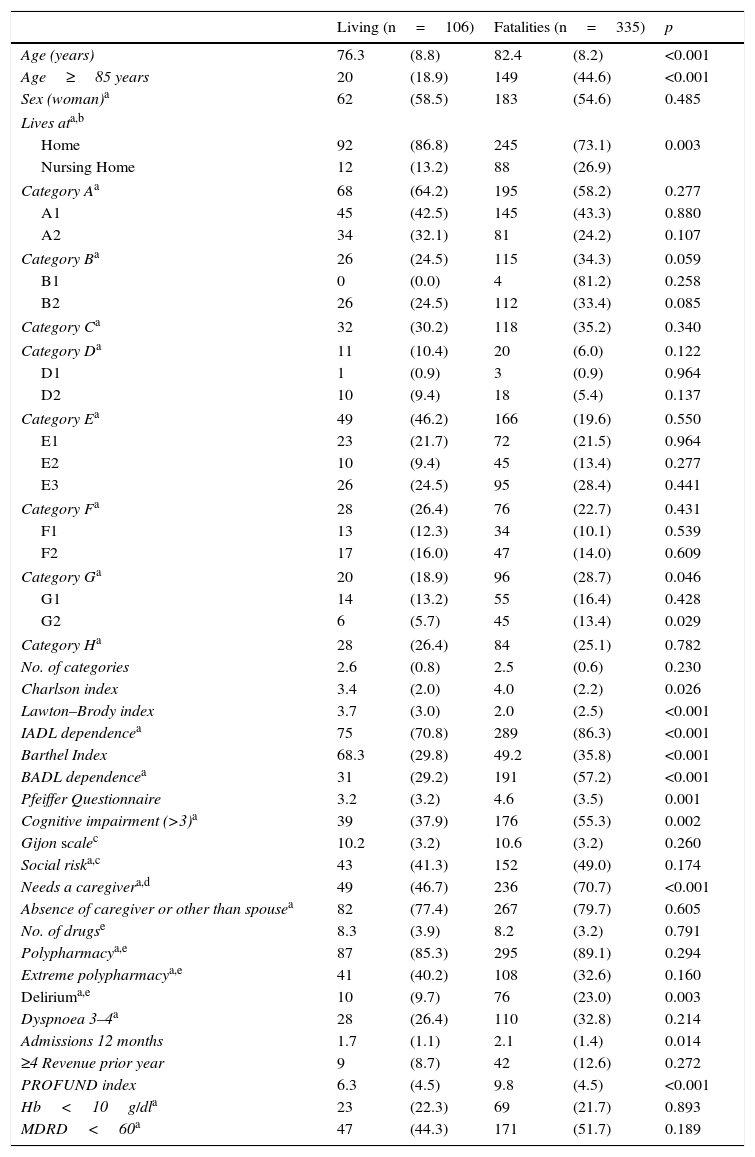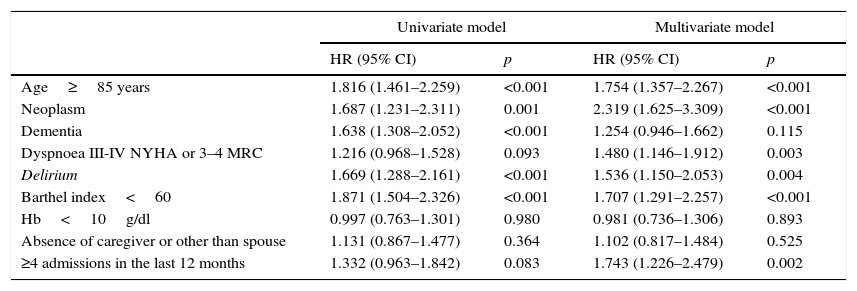To determine the usefulness of the PROFUND index to assess the risk of global death after 4 years in polypathological patients.
Patients and methodsMulticentre prospective cohort (Internal Medicine and Geriatrics) study. Polypathological patients admitted between March 1st and June 30th 2011 were included. For each patient, data concerning age, sex, living at home or in a nursing residence, polypathology categories, Charlson, Barthel and Lawton–Brody indexes, Pfeiffer questionnaire, socio-familial Gijon scale, delirium, number of drugs, haemoglobin and creatinine values were gathered, and the PROFUND index was calculated. The follow-up lasted 4 years.
ResultsWe included 441 patients, 324 from Internal Medicine and 117 from Geriatrics, with a mean age of 80.9 (8.7) years. Of them, 245 (55.6%) were women. Heart (62.7%), neurological (41.4%) and respiratory (37.3%) diseases were the most frequent. Geriatrics inpatients were older and more dependants and presented greater cognitive deterioration. After 4 years, 335 (76%) patients died. Mortality was associated with age, dyspnoea, Barthel index<60, delirium, advanced neoplasia and ≥4 admissions in the last year. The area under the curve of the PROFUND index was 0.748, 95% CI 0.689–0.806, p<0.001 in Internal Medicine and 0.517, 95% CI 0.369–0.666, p=0.818 in Geriatrics patients, respectively.
ConclusionsThe PROFUND index is a reliable tool for predicting long-term global mortality in polypathological patients from Internal Medicine but not from Geriatrics departments.
Determinar la validez del índice PROFUND para establecer el riesgo de muerte global a los 4 años en pacientes pluripatológicos.
Pacientes y métodosEstudio de cohortes (Medicina Interna y Geriatría) prospectivo y multicéntrico. Se incluyeron pacientes pluripatológicos ingresados entre el 1 de marzo y el 30 de junio de 2011. Se recogieron datos de edad, sexo, si vivían en el domicilio o en una residencia, categorías de pluripatología, índices de Charlson, Lawton-Brody y Barthel, cuestionario de Pfeiffer, escala sociofamiliar de Gijón, delirium, número de fármacos, hemoglobina, creatinina e índice PROFUND. Se realizó un seguimiento durante 4 años.
ResultadosSe incluyeron 441 pacientes, 324 de Medicina Interna y 117 de Geriatría, con una edad media de 80,9 (8,7) años, y 245 (55,6%) eran mujeres. Las enfermedades cardiacas (62,7%), neurológicas (41,4%) y respiratorias (37,3%) fueron las más frecuentes. Los pacientes de Geriatría eran de más edad, más dependientes y con más deterioro cognitivo. Al cabo de 4 años habían fallecido 335 (76%) pacientes. Los factores asociados de forma independiente con la mortalidad fueron la edad, la disnea, el índice de Barthel<60, el delirium, las neoplasias avanzadas y haber ingresado 4 o más veces en el último año. El rendimiento del índice PROFUND fue bueno en los pacientes de Medicina Interna y malo en los de Geriatría (0,748, IC 95% 0,689-0,806, p<0,001, y 0,517, IC 95% 0,369-0,666, p=0,818, respectivamente).
ConclusionesEl índice PROFUND es útil para predecir la mortalidad global a largo plazo en los pacientes pluripatológicos de Medicina Interna, pero no en los de Geriatría.












